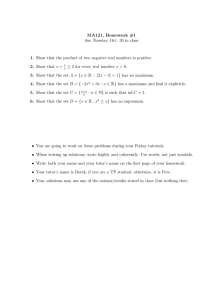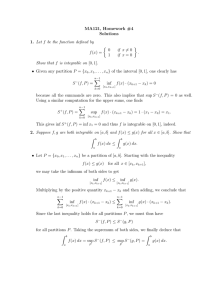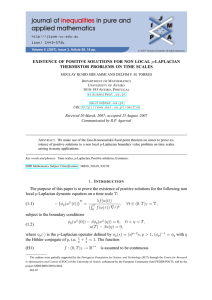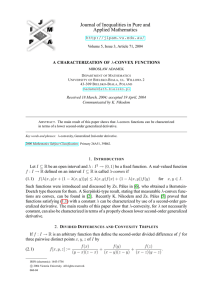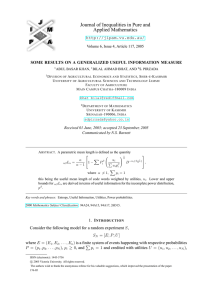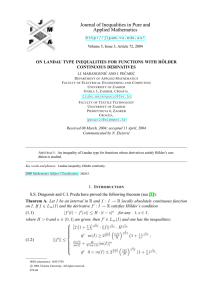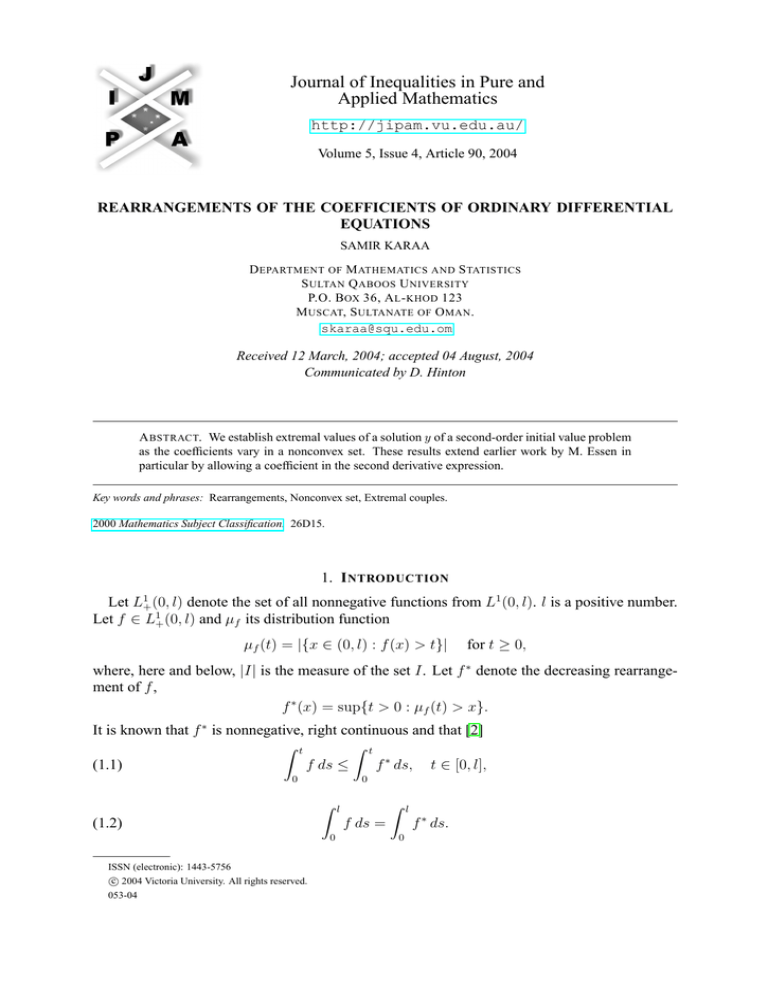
Journal of Inequalities in Pure and
Applied Mathematics
http://jipam.vu.edu.au/
Volume 5, Issue 4, Article 90, 2004
REARRANGEMENTS OF THE COEFFICIENTS OF ORDINARY DIFFERENTIAL
EQUATIONS
SAMIR KARAA
D EPARTMENT OF M ATHEMATICS AND S TATISTICS
S ULTAN Q ABOOS U NIVERSITY
P.O. B OX 36, A L - KHOD 123
M USCAT, S ULTANATE OF O MAN .
skaraa@squ.edu.om
Received 12 March, 2004; accepted 04 August, 2004
Communicated by D. Hinton
A BSTRACT. We establish extremal values of a solution y of a second-order initial value problem
as the coefficients vary in a nonconvex set. These results extend earlier work by M. Essen in
particular by allowing a coefficient in the second derivative expression.
Key words and phrases: Rearrangements, Nonconvex set, Extremal couples.
2000 Mathematics Subject Classification. 26D15.
1. I NTRODUCTION
Let L1+ (0, l) denote the set of all nonnegative functions from L1 (0, l). l is a positive number.
Let f ∈ L1+ (0, l) and µf its distribution function
µf (t) = |{x ∈ (0, l) : f (x) > t}|
for t ≥ 0,
where, here and below, |I| is the measure of the set I. Let f ∗ denote the decreasing rearrangement of f ,
f ∗ (x) = sup{t > 0 : µf (t) > x}.
It is known that f ∗ is nonnegative, right continuous and that [2]
Z t
Z t
(1.1)
f ds ≤
f ∗ ds, t ∈ [0, l],
0
0
Z
Z
f ds =
(1.2)
0
ISSN (electronic): 1443-5756
c 2004 Victoria University. All rights reserved.
053-04
l
0
l
f ∗ ds.
2
S AMIR K ARAA
The increasing rearrangement of f is simply f ∗∗ defined by f ∗∗ (t) = f ∗ (l − t). A crucial
property of rearrangements is that if f and g are nonnegative with f ∈ L1 (0, l) and g ∈ L∞ (0, 1)
then
Z l
Z l
Z l
∗∗ ∗
(1.3)
f g ds ≤
f g ds ≤
f ∗ g ∗ ds.
0
0
0
We will say that f and g are equimeasurable or equivalently that f is a rearrangement of g
if they have the same distribution function. We will denote this equivalence relation by f ∼ g.
Let f0 be a member of L1+ (0, l) and C(f0 ) its equivalence class for the relation ∼, i.e.,
C(f0 ) = {f ∈ L1+ (0, l), f ∗ = f0∗ }.
A function σ : [0, l] → [0, l] is measure-preserving if, for each measurable set I ⊂ [0, l], σ −1 (I)
is measurable and |σ −1 (I)| = |I|. Let Σ be the class of such functions. According to Ryff [6],
to each f ∈ L1+ (0, l) there corresponds σ ∈ Σ such that f = f ∗ ◦ σ. In particular, we have
C(f0 ) = {f ∈ L1+ (0, l), f = f0∗ ◦ σ, σ ∈ Σ}.
Let p and q be in L1+ (0, l) and consider the second-order differential equation
(1.4)
(p−1 (x)y 0 (x))0 + q(x)y(x) = 0,
y(0) = 1,
(p−1 y 0 )(0) = 0.
A solution of the equation is a function y such that y and y 0 are absolutely continuous and
the equation is satisfied almost everywhere. In the first part of this paper we are interested in
finding the supremum and the infimum of y(l) when the couple (p, q) varies in the set C =
C(f0 ) × C(g0 ), where g0 is also a member of L∞
+ (0, l). Consider
1
Problem 1. Determine inf y(l), (p, q) ∈ C.
Problem 2. Determine sup y(l), (p, q) ∈ C.
To solve these problems, we shall use a kind of calculus of variations which does not work
in C; this class is not convex. Following Essen [3] and [4], and recalling that C(f0 ) and C(g0 )
are weakly relatively compact in L1 (0, l), we introduce the set K = K(f0 ) × K(g) consisting
of all weak limits of sequences of C in [L1 (0, l)]2 . To simplify notations, we use the symbol ≺
introduced by Hardy, Littlewood and Polya [5]. We say that f majorates g, written g ≺ f , if
Z x
Z x
∗
f ∗ dt, x ∈ [0, l],
g dt ≤
0
0
Z
l
∗
Z
l
g dt =
0
f ∗ dt.
0
We note that if g ≺ f (f and g are in L∞
+ (0, l)) then
ess sup g ≤ ess sup f,
ess inf f ≤ ess inf g.
The relations g ≺ f and f ≺ g imply that f ∼ g. In [7], it is shown that
K(f0 ) = {f ∈ L1+ (0, l), f ≺ f0 },
and K(f0 ) is the convex hull of C(f0 ). K(f0 ) is closed and weakly compact in L1 (0, l). More
generally, K(f0 ) is weakly compact in Lp (0, l) if f0 ∈ Lp+ (0, l), 1 ≤ p ≤ ∞. According to [1],
C(f0 ) in the set of "∞-dimensional" extreme points of K(f0 ). That is if f ∈ K(f0 ) − C(f0 ),
1
The choice of p−1 instead of p is essential for the study of our problems.
J. Inequal. Pure and Appl. Math., 5(4) Art. 90, 2004
http://jipam.vu.edu.au/
C OEFFICIENTS OF O RDINARY D IFFERENTIAL E QUATIONS
3
then for any m ≥ 1, one can find f1 , . . . , fm linearly independent in K(f0 ) and θ1 , . . . , θm ∈
(0, 1) such that
m
m
X
X
θi = 1,
θi fi = f.
i=1
i=1
The following result is given in [1].
Proposition 1.1. Let h, g ∈ L1+ (0, l). Then the following are equivalent
(i) g ≺ f .
(ii) For all h ∈ L∞
+ (0, l),
Z x
Z
gh dt ≤
0
x
f h dt,
f dt.
0
(iii) For all h ∈ L∞
+ (0, l),
Z x
Z
∗ ∗
g h dt ≤
l
Z
g dt =
0
0
l
Z
∗ ∗
x
0
Z
∗ ∗
f h dt,
l
Z
l
g dt =
0
0
f dt.
0
(iv) We have
Z
l
l
Z
F (g) dt =
0
F (f ) dt,
0
for all convex, nonnegative functions F such that F (0) = 0, F is Lipschitz.
As previously remarked we will consider the following problems
Problem 3. Determine inf y(l), (p, q) ∈ K.
Problem 4. Determine sup y(l), (p, q) ∈ K.
Similar problems may be considered for the differential equation
(1.5)
(p−1 (x)y 0 (x))0 − q(x)y(x) = 0,
y(0) = 1,
(p−1 y 0 )(0) = 0.
Let then
Problem 5. Determine inf y(l), (p, q) ∈ K.
Problem 6. Determine sup y(l), (p, q) ∈ K.
Proposition 1.2. Let y be the solution of (1.4) [resp. (1.5)]. Then
inf y(l) ≤ cos(Al) ≤ sup y(l),
resp.
inf y(l) ≤ cosh(Al) ≤ sup y(l),
where A = (||f0 ||L1 ||g0 ||L1 )1/2 .
These estimates hold since the functions
p ≡ l−1 ||f0 ||L1
and
q ≡ l−1 ||g0 ||L1
are respectively members of K(f0 ) and K(g0 ).
J. Inequal. Pure and Appl. Math., 5(4) Art. 90, 2004
http://jipam.vu.edu.au/
4
S AMIR K ARAA
2. O SCILLATION AND N ONOSCILLATION C RITERIA
To simplify this section, we assume that p, p−1 and q are in L∞
+ (0, l).
Lemma 2.1. If
l
Z
l
Z
q(x) dt ≤ 1,
p(x) dt
0
0
then a solution of (1.4) does not vanish in [0, l].
Proof. Let y0 be a solution of (1.4) vanishing in (0, l], and denote by a its smallest zero. We
have
(2.1)
(p−1 (x)y00 (x))0 + q(x)y0 (x) = 0,
(p−1 y00 )(0) = 0,
Multiplying (2.1) by y0 , we then integrate by parts to obtain
Z a
Z a
Z
−1 0 2
2
2
p (y ) dx =
qy dx ≤ ymax
0
0
y0 (a) = 0.
a
q dx,
0
and then apply the inequality (y 0 and p are linearly independent)
12
21 Z a
Z a
Z a
0
−1 0 2
p (y ) dx .
p dx
|y | dx <
|ymax | ≤
0
0
0
By substitution of the bound for |ymax | into the first inequality and cancelling the term
the conclusion follows (by contradiction) since a ≤ l.
Ra
0
p−1 (y 0 )2 dx,
Lemma 2.2. If
kpk∞ kqk∞ <
(2.2)
π 2
2l
,
then a solution of (1.4) does not vanish in [0, l].
Proof. Let y0 be as in the previous proof, so that λ0 = 1 is the first eigenvalue of the problem
0
p−1 (x)y 0 (x) + λq(x)y(x) = 0, (p−1 y 0 )(0) = 0, y(a) = 0.
According to a variational principle,
R a −1
Ra 0 2
p (x)y 0 (x)2 dx
y (x) dx
−1
−1
0R
R0a
λ0 = inf
≤
kpk
kqk
inf
a
∞
∞
y(a)=0
y(a)=0
q(x)y(x)2 dx
y(x)2 dx
0
0
−1 2
−2
= kpk−1
∞ kqk∞ π (2a) .
Hence,
a2 ≥
which contradicts (2.2).
π 2
2
−1
kpk−1
∞ kqk∞ ,
The proof shows that if kpk∞ kqk∞ = π 2 /(2l)2 , then a solution of (1.4) may vanish only at
x = l. It is not difficult to show that this case holds only when p and q are constants.
The following lemma gives sufficient conditions for oscillations.
Lemma 2.3. Assume that p is nondecreasing, p−1 ∈ C 1 [0, l] and p(x) ≤ h−1 on [0, l], where h
is a positive constant. There exists a number H > 0 (depending on h) such that if q ≥ H a.e.
on (0, l) then every solution of (1.4) changes its sign on (0, l).
J. Inequal. Pure and Appl. Math., 5(4) Art. 90, 2004
http://jipam.vu.edu.au/
C OEFFICIENTS OF O RDINARY D IFFERENTIAL E QUATIONS
5
Proof. Let z(x) = (l − x)2 (l + x)2 . Multiplying both sides in (1.4) by z(x) and integrating over
(0, l), we obtain
Z l
(2.3)
y(x)[(p−1 z 0 )0 (x) + q(x)z(x)] dx = 0.
0
As p is nondecreasing we have for all x ∈ (0, l)
(p−1 z 0 )0 (x) = (p−1 )0 (x)z 0 (x) + p−1 (x)z 00 (x) ≥ p−1 (x)z 00 (x).
Let ε be a positive number such that z 00 is positive on [l − ε, l]. Suppose that y(x) ≥ 0 on [0, l].
Then (2.3) implies that
Z l−ε
(2.4)
y(x)[(p−1 z 0 )0 (x) + q(x)z(x)] dx ≤ 0.
0
Let
H > h max(−z 00 )(l − ε)−2 (l + ε)−2 .
[0,l]
Then,
(p−1 z 0 )0 (x) + q(x)z(x) ≥ hz 00 (x) + Hz(x) > 0
for all x ∈ (0, l − ε), which contradicts (2.4).
Lemma 2.4. Any solution of (1.5) is positive and nondecreasing. Moreover, if ||p||L1 ||q||L1 < 1
then
y(l) ≤ (1 − ||p||L1 ||q||L1 )−1 .
Proof. Let y be a solution of (1.5). We have
0
Z
x
y (x) = p(x)
q(t)y(t) dt,
0
which implies that y(x) ≥ 1 and y is nondecreasing. Therefore,
Z x
0
q(t) dt.
y (x) ≤ y(l)p(x)
0
Integrating both sides of the last inequality over (0, l), we get
Z l
Z l
y(l) − 1 ≤ y(l)
p(t) dt
q(t) dt.
0
0
Hence,
y(l) ≤ (1 − ||p||L1 ||q||L1 )−1 .
3. C HARACTERIZATION OF THE E XTREMAL C OUPLES
The existence of extremal couples will be discussed at the end of this section. We suppose
that f0 , g0 ∈ L∞
+ (0, l) and f0 ≥ h where h is a positive constant.
Theorem 3.1. Assume that all solutions of (1.4) are positive when (p, q) varies in K(f0 ) ×
K(g0 ). Let (p0 , q0 ) be an extremal couple for Problem 3 and y0 the corresponding solution in
(1.4). Then q0 = g0∗ and in the open set where
Z t
Z t
p0 (s) ds >
f0∗∗ (s) ds,
0
J. Inequal. Pure and Appl. Math., 5(4) Art. 90, 2004
0
http://jipam.vu.edu.au/
6
S AMIR K ARAA
we have P 0 (t) = 0 where
y00 2 (t)
P (t) = 2
p0 (t)
l
Z
p0 (t)y0 (t) dt −
−2
t
y00 (t)
,
(p0 y0 )(t)
t ∈ [0, l].
If f0 is bounded below by a positive constant then the above set is empty and p0 = f0∗∗ , i.e., the
infimum over the larger class K coincides with the infimum over the smallest class C.
Theorem 3.2. Assume that all solutions of (1.4) are positive when (p, q) varies in K(f0 ) ×
K(g0 ). Let (p0 , q0 ) be an extremal couple for Problem 4 and y0 the corresponding solution in
(1.4). Then q0 = g0∗∗ and in the open set where
Z t
Z t
p0 (s) ds <
f0∗ (s) ds,
0
0
0
we have P (t) = 0 where P is as above. If f0 is far from zero then the above set is empty
and p0 = f0∗ , i.e. the supremum over the larger class K coincides with the supremum over the
smallest class C.
Let ai and bi , (i = 1, 2), be positive numbers such that a1 < a2 and b1 < b2 . Define the sets
E and F by
Z l
∞
E = p ∈ L (0, l), a1 ≤ p ≤ a2 ,
p dx = A
0
and
Z l
∞
F = q ∈ L (0, l), b1 ≤ p ≤ b2 ,
q dx = B ,
0
where A and B are such that a1 l < A < a2 l and b1 l < B < b2 l. Then we have
Corollary 3.3. If AB ≤ 1, then inf y(l) when (p, q) varies in E × F is reached by
(
a1 if x ∈ (0, α),
p0 (x) =
a2 if x ∈ (α, l),
and
(
q0 (x) =
b2
if x ∈ (0, β),
if x ∈ (β, l),
Rl
where α and β are chosen so that 0 p0 dx = A and 0 q0 dx = B. The supremum of y(l) over
E × F is reached by p̄ = p∗0 and q̄ = q0∗∗ .
b1
Rl
A counterexample. We show that Theorem 3.2 does not hold if the solutions of (1.4) are
allowed to vanish. Set l = 2π, and let p0 ≡ 1 in (0, l) and
(
0 if x ∈ (0, l0 ),
q0 (x) =
4 if x ∈ (l0 , l),
where l0 = 3π/2. Then it is easily verified that the solution in (1.4) with (p, q) = (p0 , q0 ) is
(
1
if x ∈ (0, l0 ),
y0 (x) =
cos 4(x − l0 ) if x ∈ (l0 , l).
Let p̄(x) ≡ q̄(x) ≡ 1 in (0, 2π). The corresponding solution in (1.4) is ȳ(x) = cos x. We see
that ȳ(l) > y0 (l) in spite of q̄ ≺ q0 . The assumption in Theorem 3.1 is also necessary.
J. Inequal. Pure and Appl. Math., 5(4) Art. 90, 2004
http://jipam.vu.edu.au/
C OEFFICIENTS OF O RDINARY D IFFERENTIAL E QUATIONS
7
Proofs of Theorems 3.1 and 3.2. Necessary conditions on p0 . By the change of variable u =
−y 0 /(py), i.e.,
y(x) = e−
(3.1)
Rx
0
pu dt
x ∈ [0, l],
equation (1.4) is changed into
u0 − pu2 = q,
(3.2)
u(0) = 0.
The solution of (3.2) is written
Z
u(t) =
t
Z t
q(s) exp
p(r)u(r) dr ds.
0
s
In view of (3.1), Problem 3 is equivalent to
Z l
maximising
pu dt subject to
(p, q) ∈ K.
0
Let p0 be an extremal function for the infimum problem and p an arbitrary member in K(f0 ).
Define
pδ = (1 − δ)p0 + δp,
δ ∈ [0, 1].
We note that this type of variation is not possible in C(f0 ). Let uδ satisfy
u0δ − pδ u2δ = q0 ,
(3.3)
uδ (0) = 0.
Forming the difference of (3.3) and (3.3) with δ = 0, we have
u0δ − u00 = pδ (uδ − u0 )(uδ + u0 ) + δ(p − p0 )u20 .
Therefore,
Z
t
(p −
(uδ − u0 )(t) = δ
p0 )u20
Z
pδ (r)(uδ + u0 )(r) dr
exp
0
t
ds.
s
Writing pδ uδ − p0 u0 = pδ (uδ − u0 ) + (pδ − p0 )u0 and integrating over (0, l), we obtain
Z l
Z l Z t
Z t
2
(pδ u − p0 u0 )dt =
pδ δ
(p − p0 )u0 exp
pδ (uδ + u0 ) dr ds dt
0
0
0
s
Z
l
(p − p0 )u0 dt
Z l Z l
Z t
2
= δ (p − p0 )u0
pδ exp
pδ (uδ + u0 ) dr dt ds
+δ
0
0
s
Z
s
l
(p − p0 )u0 dt.
+δ
0
For Problem 3 the left-hand side is nonpositive. Dividing by δ and letting δ → 0+ brings
Z l
(p − p0 )(t)P (t) dt ≤ 0,
for all p ∈ K(f0 ),
(3.4)
0
where P is given in Theorem 3.1. If p0 is an extremal coefficient for Problem 4 then we find
Z l
(3.5)
(p − p0 )(t)P (t) dt ≥ 0,
for all p ∈ K(f0 ).
0
J. Inequal. Pure and Appl. Math., 5(4) Art. 90, 2004
http://jipam.vu.edu.au/
8
S AMIR K ARAA
Let us first discuss (3.4). By Ryff’s characterization, there exists σ ∈ Σ such that P = P ∗ ◦ σ.
Substituting p = p∗0 ◦ σ into (3.4) we see that
Z l
Z l
Z l
Z l
∗ ∗
(3.6)
P p0 dt =
P p dt ≤
P p0 dt ≤
P ∗ p∗0 dt.
0
0
0
0
In the last step we used (1.3) which requires that P is nonnegative. This will be proved later.
As a result, equalities hold everywhere in (3.6) and we have
Z ∞ Z
Z ∞ Z
∗
(3.7)
p0 (t) dt ds =
p0 (t) dt ds
{P (t)>s}
0
{P ∗ (t)>s}
0
for all s. As
|{P (t) > s}| = |{P ∗ (t) > s}|,
we know that
Z
Z
p∗0 (t) dt
p0 (t) dt ≤
{P ∗ (t)>s}
{P (t)>s}
for all s. It follows from (3.7) that
Z
(3.8)
Z
p0 (t) dt =
{P ∗ (t)>s}
{P (t)>s}
(3.9)
ess
inf
{P (t)>s}
p0 (t) ≥ ess
p∗0 (t) dt,
inf
{P (t)≤s}
p0 (t).
for all s. From (3.9) one deduces that if P is increasing on the interval I, then p0 must be
nondecreasing on this interval if we neglect a set of measure zero. Similarly, if P is decreasing
on some interval, p0 will be nonincreasing. If these relations hold, we say that P and p0 are
codependent.
We now return to the function P . We have P (0) = 0 and a straightforward calculation yields
Z l
q0
0
0
−2
P (t) = q0 1 − 2 y0 y0
p0 (s)y0 (s) ds
p0
t
that is nonnegative for all t ∈ (0, l). Choosing p = f0∗∗ in the variational equation (3.4) and
integrating by parts gives
Z l
Z l Z t
∗∗
∗∗
0≥
(f0 − p0 )P (t) dt =
(f0 − p0 ) ds d(−P (t)) ≥ 0.
0
0
0
We used the inequality
Z
t
Z
p0 ds ≥
0
t
f0∗∗ ds,
t ∈ [0, l].
0
Consequently,
0
Z
t
P (t)
(f0∗∗ − p0 ) ds = 0,
t ∈ [0, l],
0
and the second part of Theorem 3.1 is proved.
For the supremum problem we use the same arguments. If P = P ∗ ◦ σ, where σ ∈ Σ, we
choose p = p∗∗
0 ◦ σ in (3.5) to obtain
Z l
Z l
Z l
Z l
∗ ∗∗
(3.10)
P p0 dt =
P p dt ≥
P p0 dt ≥
P ∗ p∗∗
0 dt.
0
J. Inequal. Pure and Appl. Math., 5(4) Art. 90, 2004
0
0
0
http://jipam.vu.edu.au/
C OEFFICIENTS OF O RDINARY D IFFERENTIAL E QUATIONS
Thus, there is equality everywhere in (3.10) and
Z ∞ Z
Z
(3.11)
p0 (t) dt ds =
0
{P (t)>s}
Since
∞
Z
Z
{P ∗ (t)>s}
0
9
p∗∗
0 (t) dt
ds.
Z
∗∗
p (t) dt ≤
{P ∗∗ (t)>s}
p0 (t) dt,
{P (t)>s}
for all s, (3.11) implies that
Z
Z
p0 (t) dt =
{P ∗ (t)>s}
{P (t)>s}
ess
inf
{P (t)>s}
p0 (t) ≥ ess
p∗∗
0 (t) dt,
inf
{P (t)≤s}
p0 (t),
for all s. In this case P and p0 are contra-dependent, i.e. if P is increasing (resp. decreasing)
on an interval I, p0 will be nonincreasing (resp. nondecreasing) on I. Choosing p = f0∗ in the
variational equation (3.5) and arguing as above, we prove the second part of Theorem 3.2.
Necessary conditions on q0 . Let q0 be an extremal function for Problem 3. For q ∈ K(g0 ), we
define
qδ = (1 − δ)q0 + δq,
δ ∈ [0, 1].
Let uδ be the solution of
u 0 − p 0 u 2 = qδ ,
(3.12)
u(0) = 0.
Forming the difference of (3.12) and (3.12) with δ = 0, calculations similar to those of the
preceding case allow us to derive the necessary conditions of optimality
Z l
(q − q0 )(t)Q(t) dt ≤ 0
for all q ∈ K(g0 ),
0
where
Q(t) =
l
Z
y02 (t)
p0 (s)y0−2 (s) ds.
t
We remark that Q(l) = 0 and
0
Q (t) =
2y0 y00
Z
l
p0 (s)y0−2 (s) ds − p0
t
is nonpositive on (0, l). For Problem 4, q0 satisfies
Z l
(q − q0 )(t)Q(t) dt ≥ 0
for all q ∈ K(g0 ).
0
Reasoning as above, we deduce that q0 and Q are codependent for the infimum problem. The
argument for characterizing p0 yields q0 = g0∗ . For the supremum problem q0 and Q are contra
dependent and we get q0 = g0∗∗ which completes the proofs.
Existence.
Let m0 denote the infimum of y(l) when (p, q) varies in K and (pn , qn ) a minimizing sequence
in K. Let {un } be an associated sequence of solutions in the differential equation (3.2) so
Rl
that limn→∞ 0 pn un dt = m0 . Using weak∗ compactness, we find that (p0 , q0 ) ∈ K such that
pn → p and qn → q weakly in L∞ (0, l). From the expression of un , we see that
Z l
Rl
qn (t)e− 0 pn un ds dt ≤ ||g0 ||L1 e−m0 .
un (t) ≤
0
J. Inequal. Pure and Appl. Math., 5(4) Art. 90, 2004
http://jipam.vu.edu.au/
10
S AMIR K ARAA
It follows from (3.2) that the sequence {u0n } is uniformly bounded in L∞ (0, l). By Ascoli’s
theorem, there exists a subsequence (we may assume that it is the original sequence) such that
un → u0 uniformly in [0, l]. It is easy to check that u0 is the solution of (3.2) for (p, q) =
(p0 , q0 ). The proof of the supremum problem is quite the same.
4. P ROBLEM 6
Suppose that f0 , g0 ∈ L∞
+ (0, l) and f0 ≥ 1 over (0, l). The existence of extremal couples for
Problems 5 and 6 may be proved as above. Let
Z l
y00 2 (t)
y00 (t)
−2
P (t) = 2
p0 (s)y0 (s) ds −
,
p0 (t)
(p0 y0 )(t)
t
Z l
2
Q(t) = y0 (t)
p0 (s)y0 (s)−2 ds,
t ∈ [0, l].
t
Theorem 4.1. Let (p0 , q0 ) be the extremal couple for Problem 6, and y0 an associated solution
in (1.5). In the open set where
Z t
Z t
p0 ds >
f0∗∗ ds
0
resp.
Z
0
t
t
Z
g0∗ ds,
q0 ds <
0
0
we have P 0 (t) = 0, resp. Q0 (t) = 0.
Proof. By the change of variable u = y 0 /(py) equation (1.5) is changed into
u0 + pu2 = q,
u(0) = 0,
We shall then study the equivalent problem
Z l
max
p u dt,
t ∈ [0, l].
(p, q) ∈ K.
0
Let (p0 , q0 ) be the extremal couple for Problem 6. Arguing as above, we find that p0 and q0
satisfy the conditions
Z l
(4.1)
(p − p0 )(t)P (t) dt ≥ 0
for all p ∈ K(f0 ),
0
Z
l
(q − q0 )(t)Q(t) dt ≤ 0
(4.2)
for all q ∈ K(g0 )n
0
where P and Q are given above. Unlike the preceding case, it is difficult here to know the sign
of P and Q. We shall then proceed as above: Let y1 be the function defined by
Z l
p0 (s)y0−2 (s) ds, t ∈ [0, l].
y1 (t) = y0 (t)
t
y1 is a solution of the differential equation
0
0
(p−1
0 (x)y (x)) − q0 (x)y(x) = 0,
x ∈ (0, l),
but y1 (l) = 0 and y10 (l) = −(y0 /p0 )−1 (l). Besides, it is easy to see that y10 (t) < 0 for all
t ∈ (0, l). Let
0
0
y0
y10
y0
y10
ξ=
−
2,
η=−
+
2.
y0 p0 y1 p0
y0 p0 y1 p0
J. Inequal. Pure and Appl. Math., 5(4) Art. 90, 2004
http://jipam.vu.edu.au/
C OEFFICIENTS OF O RDINARY D IFFERENTIAL E QUATIONS
11
Then, we have
ξ 0 = 2ξ η p0 ,
η 0 = p0 (ξ 2 + η 2 ) − q0 ,
Z l
−1 ,
−2
ξ(0) =
p0 (s)y0 (s) ds
2 = η(0).
(4.3)
0
The key of deciding the sign of P and Q are the following relations
1
Q(t) = ξ(t)−1 ,
2
(4.4)
and
1 q0
P (t) =
2 p0
0
(4.5)
−1
1
.
ξ
In fact, we have
ξQ = ξy0 y1 =
(4.6)
1
1
(y00 y1 − y0 y10 ) = ,
2p0 (t)
2
and
Z l
q0
0
P (t) = 2 y0 y0
p0 (s)y0−2 (s) ds − q0
p0
t
Z l
q0
0
−2
=
2y0 y0
p0 (s)y0 (s) ds − p0
p0
t
q0
= Q0 (t).
p0
Relation (4.6) implies that ξ is positive and lim ξ(t) = ∞, t → l−. From (4.3) it follows that
lim sup η(t) ≥ 0, t → l−. Assume now that η changes its sign on (0, l). Since η(0) > 0, there
exists an interval [a, b] ⊂ [0, l) such that for some c > 0, we have
η(t) ≤ η(a) < 0,
η(t) < 0,
t ∈ [a, a + c],
t ∈ [a, b),
η(b) = 0.
Since η is assumed negative on (a, b), ξ will be decreasing on this interval. (4.4) and (4.5) imply
that P and Q are both increasing on [a, b]. From (4.1) and (4.2) we see that p0 is nonincreasing
and q0 is nondecreasing on this interval. As a result, we have
0 ≥ η(t) − η(a)
Z t
Z t
2
=
(p0 ξ − q0 ) +
p0 η 2
a
a
≥ (t − a) p0 (t)ξ 2 (t) − q0 (t) + η(a)2 ,
t ∈ (a, a + c),
since ess inf (0,l) p0 (t) ≥ 1. Arguing as in [4], we arrive at the following contradiction: η(b) ≤
η(a) < 0. Hence, η is nonnegative and ξ is nondecreasing. Taking p = f0∗∗ in the variational
equation (4.1), we obtain
Z l Z t
Z l
∗∗
∗∗
0≤
(f0 − p0 )P (t) dt =
(f0 − p0 ) ds d(−P (t)) ≤ 0,
0
J. Inequal. Pure and Appl. Math., 5(4) Art. 90, 2004
0
0
http://jipam.vu.edu.au/
12
S AMIR K ARAA
and therefore
0
Z
t
P (t)
(f0∗∗ − p0 ) ds = 0,
t ∈ [0, l]
0
which proves the first part of Theorem 4.1. To complete the proof, we choose q = g0∗ in
(4.2).
Remark 4.2. For Problem 5, the arguments for deciding the sign of η on (0, l) break down and
the problem requires the development of other arguments.
R EFERENCES
[1] A. ALVINO, G. TROMBETTI AND P.L. LIONS, On optimization problems with prescribed rearrangements, Nonlinear Analysis, 13(2) (1989), 185–220.
[2] C. BANDLE, Isoperimetric Inequalities and Applications, Pitman Monographs and Studies in Mathematics 7. Boston: Pitman, 1980.
[3] M. ESSEN, Optimization and α-Disfocality for ordinary differential equations, Canad. J. Math.,
37(2) (1985), 310–323.
[4] M. ESSEN, Optimization and rearrangements of the coefficient in the operator d2 /dt2 − p(t)2 on a
finite interval, J. Math. Anal. Appl., 115 (1986), 278–304.
[5] G.H. HARDY, J.E. LITTLEWOOD AND G. POLYA, Inequalities, Cambridge University Press, London/New York, 1934.
[6] J. RYFF, Orbits of L1 -functions under doubly stochastic transformation, Trans. Amer. Math. Soc.,
117 (1965), 92–100.
[7] J. RYFF, Majorized functions and measures, Nederl. Acad. Wekensch. Indag. Math., 30(4) (1968),
431–437.
J. Inequal. Pure and Appl. Math., 5(4) Art. 90, 2004
http://jipam.vu.edu.au/

